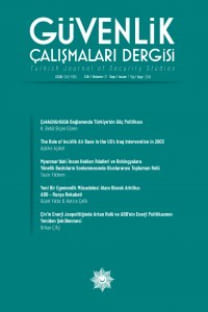Terör Örgütlerinde Radikalleşme Süreçlerinin Psikolojik Analizi: FETÖ Örneğinde İki Piramitli Model
Terörle ve radikalleşme ile mücadele uygulamalı psikolojinin önemli araştırma konularındandır. Örneğin, Temmuz 2005 Londra intihar saldırıları sonrasında normal görünümlü İngiliz vatandaşlarının nasıl intihar saldırıları gerçekleştirebildikleri ile ilgili şiddet eğilimli radikalleşme olgusu önemli bir araştırma konusu olmuştur. Diğer taraftan, 15 Temmuz 2016 FETÖ darbe teşebbüsü sonucunda 251 vatandaşımızın şehit ve yüzlercesinin gazi olması açık bir şekilde göstermektedir ki FETÖ ve benzeri terör örgütlerindeki radikalleşme süreçlerinin psikolojik analizleri Türkiye’de şiddet eğilimli radikalleşme ile mücadelede önem arz etmektedir. Bu çalışmada terör örgütlerinde yaşanan radikalleşme süreçlerinde örgüt üyelerinin hangi psikolojik değişkenlerin etkisiyle terör eylemlerine yönlendirildiği konusunda literatüre bulgularını kuramsal çerçevede inceledim. İlk olarak terör örgütlerinde radikalleşme süreçleri ve bazı bireysel ve bireyler arası değişkenler arasındaki ilişkilerin analizlerine yer verdim. Sonrasında ise terör örgütlerindeki radikalleşme süreçlerini İki-Piramitli Modele göre FETÖ yapısına belirli atıflar çerçevesinde değerlendirdim. Literatüre göre psikopatoloji veya düşük sosyoekonomik düzey gibi değişkenler ve terör örgütlerinde radikalleşme süreçleri arasında tek başına anlamlı bağlantılı [correlative] veya nedensel [casual] bir ilişki görülmemektedir. Diğer taraftan İki-Piramitli Modeline [Two-Pyramid Model] göre bazı bireyler arası değişkenler ve terörist radikalleşme süreçleri arasında pozitif bağlantılı ilişkiler bulunduğunu gösteren çalışmalar bulunmaktadır. Bu çalışmada terör örgüt yapılarının içinde yaşanan radikalleşme süreçlerinin örnek olay incelemeleri ve psikolojik modeller ile araştırılmasının önemine dikkat çekmeyi amaçlamaktayım
Anahtar Kelimeler:
FETÖ, Göreceli Yoksunluk, Terörizm, İkili Piramit Model, Sosyal Kimlik Kuramı, Merdiven Modeli.
Psychological Analysis of Process of Radicalization in Terrorism Organizations: Two Pyramid Model in the Case of FETÖ
Counter terrorism and radicalization are important research topics in applied psychology. For instance, after July 2005 suicide attacks in London, the phenomenon of violent radicalization became a hot topic as to how seemingly ordınary British citizens could commit suicide attacks. Moreover, the 2016 FETÖ coup attempt with 251 martyrs and hundreds of ghazis evidently show that psychological examination of radicalization process in FETÖ and similar terror groups is significant to counter violent radicalization in Turkey. In this paper, I reviewed the literature on how terrorist group members are persuaded to carry out terror attacks via psychological variables. First, I examined the radicalization processes of terrorist organizations on some individual and interpersonal variables. I then analyzed the radicalization processes in terror groups based on the Two-Pyramid Model with specific reference to FETÖ. The literature does not show any significant direct correlative or causal relationship between radicalization processes in terror groups and psychopathology or low socioeconomic status. On the other hand, based on the Two-Pyramid Model there are positive correlative relationships between interpersonal variables and terrorist radicalization. In this paper, I intended to draw attention on the importance of examining the radicalization processes in terrorist groups with case studies and psychological models
___
- Carpenter, J. (1997). Revive us again: The reawakening of American fundamentalism. Oxford: Oxford University Press.
- Crayton, J. W. (1983). Terrorism and psychology of the Self. L. Z. Freedman, & Y. Alexander (Eds), Perspectives on Terrorism (pp. 33-41). Wilmington, Delaware: Scholarly Resources.
- Crenshaw, M. (1981). The causes of terrorism. Comparative Politics, 13, 379-399. http://dx.doi.10.2307/421717
- Dalgaard-Nielsen, A. (2008). Studying violent radicalization in Europe. Part II. The potential contribution of socio-psychological and psychological approaches. DIIS Working paper. Copenhagen: Danish Institute for International Studies.
- Dalgaard- Nielsen, A. (2009). Counter-terrorism and civil rights of Muslims minorities in the European Union. In A. Sinno (Eds.), Western politics. Indiana: Indiana University Press.
- Ferracuti, F. (1998). Ideology and repentance: Terrorism in Italy. In W. Reich (Eds.), Origins of terrorism. Psychologies, ideologies, theologies, states of mind. Washington: Woodrow Wilson Center Press.
- Gurr, T, (1970). Why Men Rebel. Princeton: Princeton University Press.
- Levine, S. (1999). Youth in terroristic groups, gangs, and cults: The allure, the animus, and the alienation. Psychiatric Annals, 29(6), 342-349. http://dx.doi.org/10.3928/0048- 5713-19990601-08
- Moghaddam, F. M. (2005). The staircase to terrorism: A psychological exploration. American Psychologist, 60, 161-169. http://dx.doi.org/10.1037/0003-066X.60.2.161
- Maskaliunaite, A. (2015). Exploring the theories of radicalization. International Studies Interdisciplinary Political and Cultural Journal, 17(1), 9-26. http://dx.doi:10.1515/ ipcj-2015-0002
- McCauley, C., & Moskalenko, S. (2017). Understanding political radicalization: The two-pyramid model. American Psychologist, 72 (3), 205-216). http://dx.doi:10.1037/ amp0000062
- Milgram, S. (1963). Behavioral study of obedience. Journal of Abnormal and Social Psychology, 67, 371-378. http://dx.doi.org/10.1037/h0040525
- Neumann, Peter. (Eds.). (2008). Perspective on radicalization and political violence. London: International Centre for the Study of Radicalization and Political violence.
- Porta, D.D. (2013). Clandestine political violence. Cambridge: Cambridge University Press.
- Post, J. (1990). Terrorist psycho-logic: Terrorist behavior as a product of psychological forces. In Reich, Walter (Eds.), Origins of terrorism. Psychologies, ideologies, theologies, states of mind. Washington: Woodrow Wilson Center Press.
- Rubenstein, R. (1987). Alchemists of revolution. Terrorism in the modern world. New York: Basic Books.
- Sherif, M., Harvey, J.O., White, B.J., Hood, W.R., & Sherif, C.W. (1961) Intergroup Conflict and Cooperation: The Robbers Cave Experiment. Norman: University of Oklahoma Book Exchange, 1961.
- Stampnitzky, Lisa. (2014). Disciplining terror: How experts invented “Terrorism”. Cambridge: Cambridge University Press.
- Suedfeld, P., Cross, M. R. W., & Logan, M. C. (2013). Can thematic content analysis separate the pyramid of ideas from the pyramid of action? A comparison among different degrees of commitment to violence. In H. Cabayan, V. Sitterle, & M. Yandura (Eds.), Looking back, looking forward: Perspectives on terrorism and responses to it (Strategic Multi-Layer Assessment Occasional White Paper). İndirildiği yer
- https://www.researchgate.net/profile/David_Mandel3/publication/258488119_ Counterterrorism_and_Muslim_public_opinion/links/0c960528501a532dc1000000. pdf#page_65
- Tajfel, H., & Turner, J. C. (1979). An integrative theory of intergroup conflict. In W. G. Austin, & S. Worchel (Eds.), The social psychology of intergroup relations (pp. 33-37). Monterey, CA: Brooks and Cole.
- Türk Dil Kurumu. (2018). Türk Dil Kurumu büyük Türkçe sözlük online. Alınan yer
- http://www.tdk.gov.tr/index.php?option=com_ bts&view=bts&kategori1=verilst&ayn1=bas&kelime1=radikalizm
- ISSN: 2148-6166
- Başlangıç: 2000
- Yayıncı: Polis Akademisi Başkanlığı
